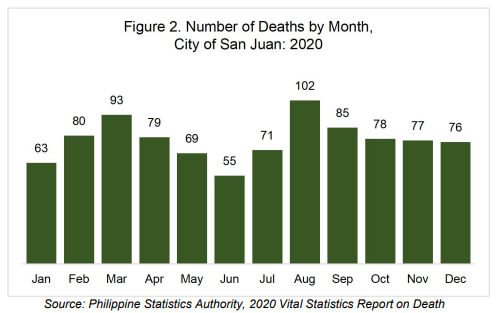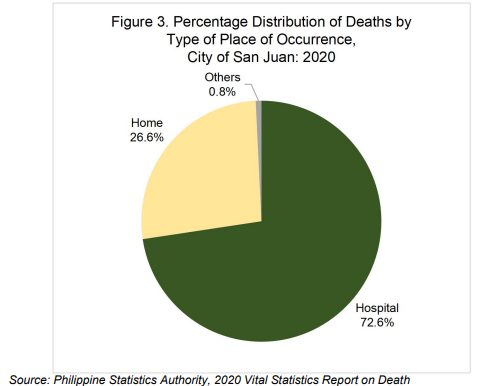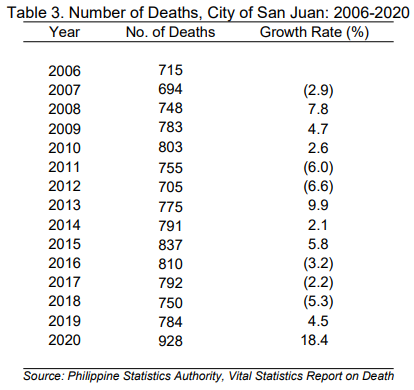Deaths increase by 18 percent in 2020 than the previous year
In 2020, 613,936 deaths were registered in the Philippines; of which 84,355 were residents of National Capital Region (NCR). Compared to previous year, the number of deaths in the Philippines decreased by 1.0 percent; contrary to NCR that increased by 7.3 percent in the same year. Meanwhile in the City of San Juan, 928 deaths by its residents were registered in 2020. This is 18.4 percent higher than the previous year. (Refer to the table below)

Figure 1 illustrates that the number of deaths in the City of San Juan from 2006 to 2020. In 2020, when the global pandemic hit, the death toll rose to 928—making it the year with the highest number of deaths recorded in the city during the period.
Deaths in 2006 stood at 715 then decreased to 694 in 2007. Over the next three (3) years, the number of deaths rose steadily; reaching to 803 in 2010. Afterwards, the City of San Juan experienced fluctuations in the number of deaths.

Most deaths occur in the third quarter
The monthly average of deaths by the residents of the city was recorded at 77. This translates to three (3) deaths on the average each day.

Figure 2 shows the number of registered deaths by month. August occurred the highest number of deaths with 102 (11.0%); followed by March and September with 93 (10.0%) and 85 (9.2%), respectively.
On the contrary, June had the lowest number of occurrences with no more than 100 (55 or 5.9%).
More males die than females
Based on the results from the 2020-registered certificates of death, more male residents of the city died than females. Out of 928 deaths, 516 (55.6%) were males while 412 (44.4%) were females.
Deaths soar for older people

Deaths across all age groups increased, except between ages five (5) to nine (9) years old and 25 to 29 years old, in 2020. However, it was most prevalent among seniors age 60 years old and over with 602 (64.9%). Additionally, deaths among seniors were notably high compared with the previous year—soaring by 72 (13.6%). This increase was largely driven by COVID-19 (127 or 21.1%) and acute myocardial infarction, also known as heart attack (103 or 17.1%). Furthermore, deaths among age group 30 to 34 rose the fastest. In 2019, the deaths were recorded at 10 then increased more than double (25 or 150%) in the succeeding year. (Refer to Table 2)
Around 800 deaths are medically attended
In 2020, 812 (87.5%) of deaths were medically attended. A death is considered medically attended if a medical assistance was provided by a private physician, public health officer, or hospital authority.
On the other hand, nine (1.0%) deaths were attended by others—medico legal officer, pathologist, and other medical practitioners. While the rest (107 or 11.5%) is accounted for none or not stated.
About three-quarters of the total number of deaths occurred in the hospital

Figure 3 presents the percentage distribution of the deaths in the City of San Juan by Type of Place of Occurrence. It shows that most of the registered deaths in 2020 occurred in the hospital with 674 (72.6%). On the other hand, 247 (26.6%) occurred at home while rest (7 or 0.8%) occurred in places other than home and hospital.
Nearly 22 out of 100 people die of COVID-19
The top three (3) causes of death in the City of San Juan are COVID-19 with 201 (21.7%), acute myocardial infarction or heart attack with 142 (15.3%), and unspecified diabetes mellitus with 28 (3.0%)







(SGD.) Amelia G. Basilio
Chief Statistical Specialist
Officer-in-Charge
